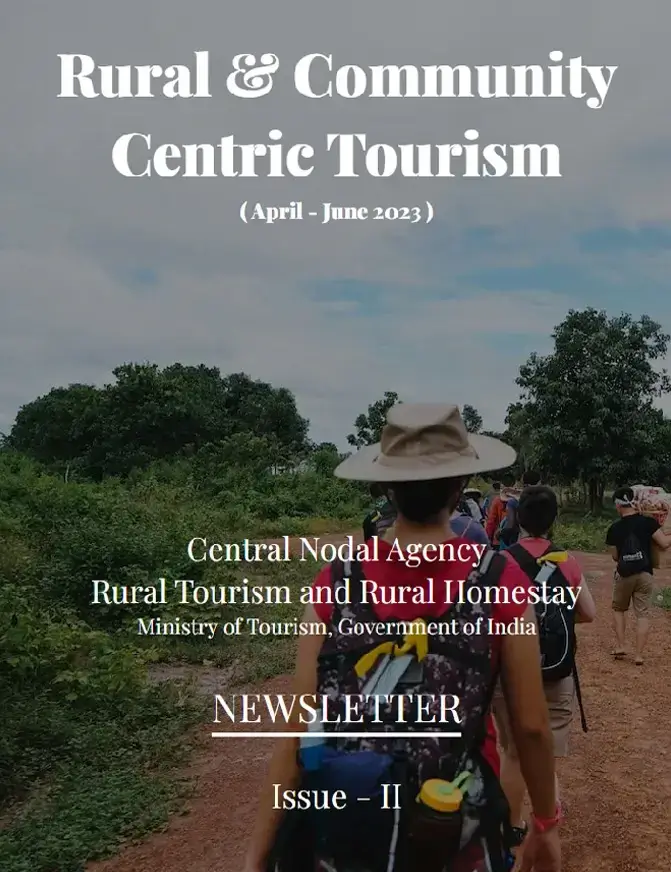 |
 | Highlights | 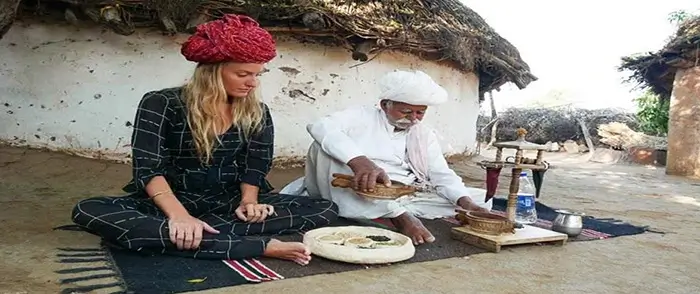 | State Review Meeting for the Best Tourism Village Competition  Ministry of Tourism, Government of India has launched the Best Tourism Village Competition in the month of February. This competition was designed to identify and celebrate exceptional villages in India that have made remarkable progress in tourism development and have the potential to offer unique experiences to visitors. CNA-RT & RH hosted a Review meeting with the states for the progress of Best Tourism Village Competition under the chairmanship of Shri Rakesh Verma Addl. Secretary (Tourism), Government of India. | State Meeting for the District Level Evaluation of the Best Tourism Village Competition  The first phase of the Best Tourism Village Competition was ended on 18 May 2023 and the district level evaluation was started from 19 May 2023. In the district level evaluation, the districts will evaluate the entries from their respective districts and will forward the three best villages for the second round. CNA-RT & RH hosted a meeting with the states for the familiarization with the district evaluation process of the Best Tourism Village Competition under the chairmanship of Shri Rakesh Verma Addl. Secretary (Tourism), Government of India. | Insights - Page1,2 ............Highlights
- Page3 ......#RuralTourism Buzz
- Page4 ......#RuralTourism Villages
- Page5 ......#RuralTourism Homes
- Page6,7 ......#TrailBlazers
- Page8,9 ...Featuring State
- Page10,11 ............Industry Initiatives
- Page12 ....#RuralTourism Abode
- Page13 ....#RuralTourism Routes
- Page14 ....#RuralTourism Comic
- Page15 ....#RuralTourism Trivia
|
| 1Central Nodal Agency Rural Tourism and Rural Homestays |
 | | Session on Rural Tourism for the University of Mumbai  University of Mumbai invited Dr. Kamakshi Maheshwari, Nodal Officer, Central Nodal Agency Rural Tourism and Rural Homestay, for sensitizing the students about Rural Tourism. Dr. Maheshwari talked about the potential of Rural Tourism in India and the growing trends in it. She also updated the student about the initiatives taken by the Ministry of Tourism, Government of India for the development of rural tourism in India along with the features of the National Strategy and Roadmap for the Development of Rural Tourism in India. | FAM Trip to Jadung 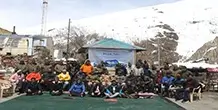 Under the guidance of Shri G. Kishan Reddy, Ministry of Tourism has identified a rural tourism cluster to be developed in Uttarakhand. CNA-RT & RH was invited by Uttarakhand Tourism Development Board (UTDB) for the first familiarization tour to the cluster including Harsil, Mukhba, Dharali and Jadung. The main objective of the familiarization (FAM) trip was to conduct a preliminary survey of the villages in order to gather essential information for planning and executing the necessary actions in the subsequent steps of tourism development. | Session on Rural Tourism in Ujjain 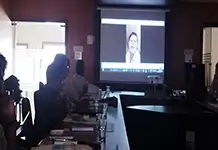 CNA-RT&RH was invited by EQUATIONS to deliver a session on the Rural Tourism in the Stakeholder Consultation Workshop held in collaboration with the Ujjain Municipal Corporation. The session on rural tourism revolves around the holistic development of the rural community along with the sustainable efforts. The session sought to inspire and educate the workshop attendees, which likely included representatives from the Ujjain Municipal Corporation, local businesses, community organizations. |
| 2Central Nodal Agency Rural Tourism and Rural Homestays |
 | #RuralTourismBuzz | Vibrant Village Program | Soul of India Lives in its Villages
- Mahatma Gandhi | India shares its land border with seven different countries spread over a distance of more than 15,000 Km. Border villages in India are home to resilient communities that strive to maintain their way of life. The residents rely on agriculture, livestock rearing, and other traditional occupations for their livelihoods. The government of India has implemented various development schemes and initiatives to improve the living conditions in border villages, enhance infrastructure, provide better education and healthcare facilities, and promote economic opportunities. For the same, Union Home Minister and Minister of Cooperation Shri Amit Shah on the first day of his trip to | Kibithoo Village in Arunachal Pradesh launched the Vibrant Village Program on 10th April 2023. Under the visionary leadership of Honorable Prime Minister Shri Narendra Modi, the Government of India has approved the ‘Vibrant Villages Programme’ (VVP) for the Financial Years 2022-23 to 2025-26. With around 6 lakh villages in India, the Vibrant Villages Program will focus on the villages situated on the borders of India. The program will focus on reducing the disparities in the development of the border villages lying in the distant edges of the country by bringing the development opportunities in the border villages. | 2967 villages in 46 blocks of 19 districts are identified abutting the northern border in the states of Arunachal Pradesh, Sikkim, Uttarakhand & Himachal Pradesh and UT of Ladakh have been identified for comprehensive development. In the first phase, 662 villages have been identified for priority on coverage, which includes 455 villages in Arunachal Pradesh. The Ministry of Tourism, Government of India is also working to develop tourism in the border villages. Formulation of National Strategy and Roadmap for the Development of Rural Tourism India is also assisting in developing the rural tourism clusters. Promotion of tourism in these areas will bring employment and development opportunities to the areas. Know More |
| | 3Central Nodal Agency Rural Tourism and Rural Homestays |
 | #RuralTourismVillages | 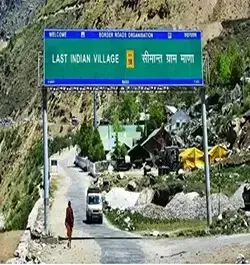 | MANA, UTTARAKHAND: THE FIRST VILLAGE OF INDIA Mana Village, also known as Mana Gaon, is a tiny village in the Chamoli district of Uttarakhand, India. It is considered to be the first Indian village within the Indo-Tibetan border. Mana village is mentioned in India's Vibrant Village. This charming community offers one-of-a-kind opportunity to immerse oneself in the spiritual, rural and natural splendour of the Himalayas. Apart from its cultural and historical significance, Mana Village offers a range of adventure activities such as trekking, rock climbing, and camping. Visiting this quaint village is significant because of its proximity to borders and the unique challenges and possibilities linked with its geographical position and it enables people to become familiar with the diverse cultures, customs, foods, and ways of life of the two nearby countries. Know More |
| KIBITHOO, ARUNACHAL PRADESH: A HIDDEN GEM OFNORTHEAST INDIA Kibithoo is a small village in the Indian state of Arunachal Pradesh's Anjaw district, located at across roads between China to the north and Myanmar to the east. Kibithoo is currently added to the list of Vibrant Villages, and it is remarkable for being one of India's final inhabited communities before the international boundary with China. The Chinese Army bunkers on the other side of the border can be clearly seen from the top of the village. Kibithoo offers a chance to learn more about the geopolitical dynamics of the area. Tourists may experience how borders are managed, how border security is conducted, and how political and diplomatic issues are taken into account while preserving border ties. Kibithoo is Arunachal Pradesh's second BPM (Border Personal Meeting) Point, following Bumla in Tawang. Representatives of the Indian and Chinese troops meet at BPM places to settle any issues. Know More | 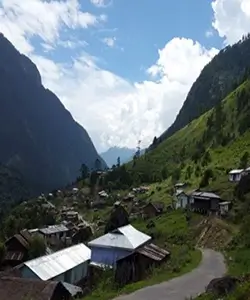 |
| 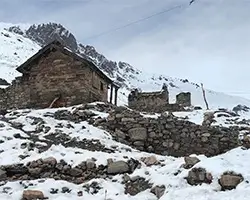 | JADUNG, UTTARAKHAND: VILLAGE FROZEN IN TIME The village of Jadung is located in the Uttarkashi district of Uttarakhand, India. Jadung is a remote village located near the Tibetan border. Jadung is a village that was evacuated during the 1962 war with China. It is said that the village since then is longing for the presence of its residents. Its proximity to the border and the cultural and natural magnetism made it to the list of Vibrant Villages. Uttarakhand Government is focussing to work on developing Jadung as a tourism destination. |
| 4Central Nodal Agency Rural Tourism and Rural Homestays |
 | #RuralTourismHomes | Sahas Farm Stay 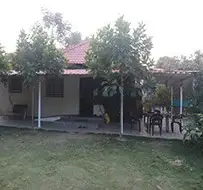 In the village of Jeedipally, close to Hyderabad, Telangana, India, you have the opportunity to dig deeply into India at Sashas Farm stay. Sashas Farm stay is ready to assist you if you want to get off the beaten path of mass tourism and genuinely experience Rural Tourism. Authentic Telangana country life, poolside parties, and barbeque get-togethers are all available to visitors at Sashas Farm stay. | Modernly styled rooms that are clean and comfy are offered by the farm stay. The gracious hospitality offered by the host, Mr. Joseph Gururaj Garu, is one of the pleasures of visiting Sashas Farm stay. They are renowned for being friendly, making sure that guests feel at home and at ease throughout their stay. On the occasion of World Tourism Day 2022, by Government of Telangana, presented the award for Best Farm Stay to Sashas Farm stay. Sashas is a classic farmhouse with a pleasant environment. The location is hidden within a farm and offers families and friends a farm experience without compromising on service. After retiring, Mr. Joseph Gururaj Garu started farming and eventually allowed visitors to stay at his | farmhouse for an unforgettable experience. To make the greatest use of the property, he registered with AIRBNB, a worldwide known website with a presence all over the world for home/farm stays. Finally, Sashas Farm stay has been certified and recognized by the Government of Telangana Department of Tourism. 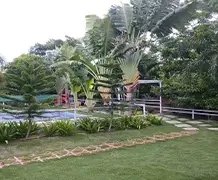 Know More |
| 5Central Nodal Agency Rural Tourism and Rural Homestays |
 | #RuralTourismTrailBlazer | Integrating Conservation and Tourism- The Sarmoli Way A Community’s Collective Approach through Sustainable Tourism | 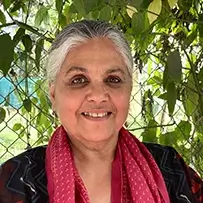 Ms. Malika Virdi, Himalayan Ark.malika.virdi@gmail.com In 2003, when Malike Virdi was first elected the sarpanch, head of Van Panchayat of the Sarmoli-Jainti Van Panchayat, she was confronted with the situation of a village community getting progressively alienated from their forest commons that had hitherto been the basis for their natural resource dependent lives and lifestyles. While this unfolding scenario across the state of Uttarakhand led to out-migration and the much talked about ghost villages, Sarmoli, a village located at 8000 feet in Munsiari Block close to the Indo-Nepal-Tibet trijunction, took up the challenge of opening their homes and village to community-based tourism. With Nanda Devi East, Trishuli and Hardeol peaks to the north and the snowcapped Panchachuli peaks across the Gori valley to the east, Sarmoli village is situated on the first rise of the Greater Himalaya in the border district of Pithoragarh in the mountain state of Uttarakhand. The villagers, especially women, now run marathons, homestays, are high altitude guides, can effortlessly identify the mountain birds and butterflies, and are Panchs and Sarpanchs of the village. They are champions of protecting their forests; they move mountains! | In 2004, as sarpanch, Malika Virdi enabled a dozen right holder families of the Van Panchayat to come forward to host tourists in their homes. Families who did not have a room to spare trained to become bird, nature and high-altitude guides, or then produced woolen handloom and artifacts for the growing tourist traffic to the village. Over time, commonly agreed upon guidelines and rules were evolved, with active participation in stewardship of the commons being the primary condition to being part of this enterprise. In addition, a roster system for hosting guests was established, giving priority to those families that had the least options to earn otherwise. This ensured creating a viable livelihood and bringing in much needed cash income into the local economy by hosting traveler from different cultures and geographies, conserving the commons and taking pride in their own ways of life. Starting with homestays, day hikes, treks and expeditions-food, culture, nature and adventure- it was predicated on notions of social equity and environmental justice, and not without its fair share of challenges and some initial skepticism. In 2016, Malika Virdi went on to found 'Himalayan Ark', now a registered entity, under which village homestays operate and lead to Sarmoli becoming well known as a ‘homestay village'. Here, each family remains the owner of their individual home stays, with a deep sense of pride and earns 80% of revenue generated from tourism. | The rate of return on every rupee invested by the family in upgrading and improving their own home is high. Soft, interest free loans have been provided by Himalayan Ark to build attached bathrooms, retrofit the houses with traditional wood carving, use solar lights and inverters and bring in a degree of quality and standardization by provide bed linen that compares with the best of hotels. At the same time, Himalayan Ark has brought together the Home stays and with a maximum of 3 rooms per Home stay, the village can host upto 60 tourists on any given day. This has enabled Himalayan Ark to tap into the market of large groups of tourists- from those on trekking or mountaineering expeditions, friends and families to individual travelers. Because of this collectivization of assets, while tourists are hosted by the individual family, they are welcomed as a guest of the village at large and can relate to more than just the host family. This collectivization is also critical in broad basing the benefits from tourism by bringing on board families from different caste and class backgrounds. And most significantly, by working together, those who run the home stays and work as guides have the assurance of a safety net both in running their tourism enterprise and in times of conflict in their everyday lives. While the Home Stay operate as family units, it is the woman head of the household who is the primary worker and gets the income. These women are members of the local women’s collective- Maati and are |
| 6Central Nodal Agency Rural Tourism and Rural Homestays |
 | | expected to be active as citizens of the rural community. There is a formula of ‘dukh-sukh’ or being together in the good and the bad times, and being part of the tourism enterprise is contingent on active participation. For instance, though traditionally alcohol is brewed in the village, it is not served to tourists by the Home Stay owners as there is a widespread problem of alcoholism in mountain communities and all women are committed to fighting it. This has engendered a sense of solidarity in committed to the larger wellbeing of the community. While the Home Stay operate as family units, it is the woman head of the household who is the primary worker and gets the income. These women are members of the local women’s collective- Maati and are expected to be active as citizens of the rural community. There is a formula of ‘dukh-sukh’ or being together in the good and the bad times, and being part of the tourism enterprise is contingent on active participation. For instance, though traditionally alcohol is brewed in the village, it is not served to tourists by the Home Stay owners as there is a widespread problem of alcoholism in mountain communities and all women are committed to fighting it. This has engendered a sense of solidarity in committed to the larger wellbeing of the community. Over the 2 decades of its operation, the revenue generated through tourism has significantly changed the economic profile of the village. Yet right from it’s inception, it was understood that it is the rural lifestyle and traditional livelihoods will not be second to tourism. The home stay family will serve a hot breakfast and dinner of the local cuisine and will give a packed lunch to the visitors and then go out and work through the day in their agricultural fields or weave their traditional woolen products. Tourist and travelers are welcomed to join into the everyday rhythm of rural life as per the season. Guides continue to work on their agricultural fields and other forms or rural employment and work as guides as and when the opportunity presents itself. What set Himalayan Ark and Sarmoli village apart from the many tour operating companies, aggregator platforms and over 3900 individual home stays registered with UTDB (2021 data) in Uttarakhand is in the fine grain that defines it as a model of responsible and equitable tourism model. The challenge for any rural tourism enterprise is that individual village homes do not have the means compete with tour operators or the hotel industry, nor can they thrive in a highly competitive market of online bookings. | 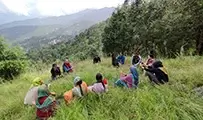 The challenge for any rural tourism enterprise is that individual village homes do not have the means compete with tour operators or the hotel industry, nor can they thrive in a highly competitive market of online bookings. In addition, village assets like the natural heritage, the forest and water resources and the landscape are commonly owned, yet profits from tourism accrue to the individual. And the impact and pressure of tourist footfalls has to borne by the community at large. In such a situation, to be responsible for making tourism a viable livelihood option that benefits the region and the rural population, the village community of Sarmoli has remained in the driver’s seat as owners and been reduced to mere service providers to tourists and larger well-heeled tour companies. The key elements that have contributed to the success of this model have been the centrality and sustained link with the Van Panchayat or forest commons, a destination approach and maintaining rural lifestyle as the center-piece of the tourist experience. Till today, a certain percentage of the income from tourism is channelized towards the upkeep of Van Panchayats that govern the Forest Commons, an institution unique to Uttarakhand. This fund helps in managing all conservational activities like paying for the ‘chowkidari’, revival of Mesar Kund- a forest reservoir, building the wall to prevent floods, tree plantations, building nature trails, forest water management and many more to sustainably manage their forest ecosystems. However, only the families who contributed their work for conservational activities get to host the guests. This reinforced people to take part in protecting their own forests. Himalayan Ark has used the intimate knowledge that the villagers have of their landscape and the wildlife and helped upskill them to become reputed bird and nature guides and educators. Now, the members of the community are trained in birding, they are high altitude trek guides, they can effortlessly identify the names of all butterflies and moths, they are story tellers; their voices have reached beyond mountains and oceans through Voices of Rural India, an initiative started during the Covid lockdown. Tourism remains just one livelihood option embedded in the community that continues with traditional livelihoods of agro-ecological farming and wool work. | This served the community well during the prolonged lockdown when all income from tourism dried up. It has rallied the village community to create a village level Tourism Sub-Committees to make all tourism units accountable. And has been responsible for creating the Munsiari Union for Sustainable Tourism and Munsiari Tour Operators Union. Himalayan Ark has evolved a Tourism Carrying Capacity assessment model that any rural mountain community can use to determine the limits of acceptable change induced through tourism. Through institutional partnerships with various organisations, Himalayan Ark is innovating new methods to up their game. Actively using social media as a means for brings their story and narrative on the national stage, adopting innovative poly house techniques for farming; or running a Café and Media Hub in collaboration Maati Sangathan, a women’s collective and Himal Prakriti- a trust for nature; the community has truly become a trailblazer for inclusive and sustainable tourism promoting conservation and livelihoods. The annual ‘Himal Kalasutra Festival’ and ‘Mesar Van Kautik’ or the Mesar Forest Fair, the community festivals in the month of May every year, is a witness to their ways of acknowledging forests and their rich culture. Film appreciation and film making workshops to tell their stories, birding and butterfly festivals, marathons and mela, the celebration runs for weeks together, attracting nature and culture enthusiasts from across the country and helps bridge the urban-rural divide. Recognition and support has been forthcoming from the UTDB and District Tourism Development Offices have sent nearly 500 home stay aspirants for capacity building exposure visits. Today, Himalayan Ark is recognized as a model for responsible tourism for villages across Uttarakhand and other states like Madhya Pradesh’s MPTDB as well as the those committed to responsible tourism withing the industry nationally. Malika Virdi has served on the Jury of several responsible tourism awards including the Outlook Traveler RT Awards and that of The Better India. 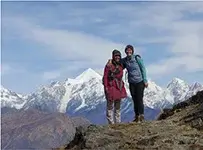 Know More |
| 7Central Nodal Agency Rural Tourism and Rural Homestays |
 | Featuring State | TELANGANA 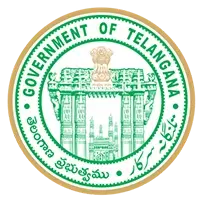 Telangana has a tremendous potential for Rural Tourism and is a fascinating canvas of myriad colours, cultures and customs. Handicrafts represent perhaps the oldest traditions of living culture and Telangana has some of the richest sources of handicrafts. The rural handicrafts provide a valuable contribution to Telangana’s tourism product. Rural Tourism projects identified in Telangana, by the Ministry of Tourism, Govt. of India are Pochampally Rural Tourism Project, Yadadri Bhuvanagiri District, and Nirmal Rural Tourism project, Nirmal Dist., Cheriyal Rural Tourism Project, Siddipet and Pembarthi Rural Tourism Project, Jangaon Dist. In a bid to create its own cultural identity after being carved out as a separate state from Andhra Pradesh, the Telangana government has been reviving local art and dance forms. | The Government has provided a platform to the artisans of Rural Tourism Projects i.e. Pochampally, Cheriyal, Pembarthy & Nirmal to exhibit their products in the Museum Building, marketing their products through, brouchers & wall posters and social media i.e. websites, facebook etc. for live demonstration, a small canteen for the visitors and also conducting training to the school / college going students / interested youth for art lovers i.e. educational tour for generating awareness and employment Pochampally Rural Tourism 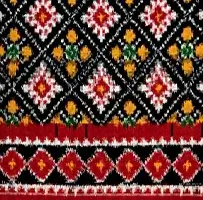 Pochampally, a 28-square km weavers’ hamlet on the outskirts of Hyderabad (45 km) & 25 km from Ramoji Flim City. Awarded as 'Best World Tourism Village’ by UNWTO. Popularly known for famed IKAT style (G.I. status in 2004) whose creations include the attractive “Tie and Dye” and Silk oven sarees. Also known as silk city of India. | 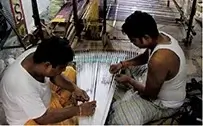 Nirmal Rural Tourism Nirmal district has rich historical and cultural traditions. Several art forms flourish in the district viz. Bindu Yakshaganam, Bagavatham, Pandavulu, Yellamma Katha, Sharada Kathalu, Kolatam and Jada Koppulu. Nirmal wood Toys, and Nirmal Paintings with Natural Colours (G.I status for both in 2009) have earned national and international recognition. Mughal miniatures’ paintings are very attractive and loved by art collectors. The motif of Nirmal arts derieved from the designs found in Ajanta & Ellora forms and Mughal miniature art. All the artists have come together to form a cooperative society to support the dying art forms (The Nirmal Toy and Art Industries Cooperative Society Ltd.). With the help of the government, the society conducts workshops with the motive of reviving the art forms and training interested individuals to learn about the art form and its history. The Nakkashi community won the prestigious Kalamani Award during the 30th Surajkund International Craft Mela held in Haryana, India in 2016. |
| 8Central Nodal Agency Rural Tourism and Rural Homestays |
 | | Cheriyal Rural Tourism 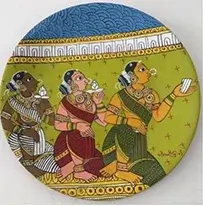 The name Cheriyal painting is derived from the Cheriyal village, Siddipet district (90 km from Hyderabad). Cheriyal paintings (G.I. status in 2007) essentially consists of scrolls that depict stories from the epics, puranas, and folktales, and was once an integral part of the religious, social, and cultural lives of the villages in Telangana. The art form is considered to be modified version of Nakashi artform with rich in local motifs. 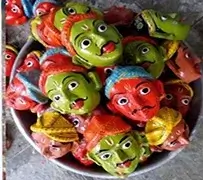 “All India Handicraft Board” get aware about the artform in 1975, since then government is helping by exhibiting the art at various handicraft exhibitions and festivals. The Hyderabad chapter of FICCI Ladies | Organization (FLO), came up a new initiative to promote 400 years old craft of Cheriyal Scroll painting that is native to Telengana. ‘Tirumani’, an organization is helping to revive the artform and teach organisational skills to the local artisan community. Pembarthi Rural Tourism  Pembarthi is a village in Jangaon district, Telangana. Pembarthi is globally known for its metal handicraft and brass work. There are 600 metal art workers in Prembathi, who are locally known as Vishwakarma. In 2011, the 25th Surajkund Mela, a huge handicrafts fair showcasing handicrafts from all over the country selected our state as the theme state.  At present, the Vishwakarma Society for Brass, Copper and Silver Industrial Cooperative Society has been set up to provide for the growth and promotion of this unique art form. | The society in association with Telangana government also organizes seminars and workshops for school and college students as well as Tourists. Conclusion - Rural Tourism Project spearheaded to local employment generation, improved quality of life and livelihood options of the local community.
- Enhanced cultural significance & sense of cultural identity among community.
- Provided better access to higher education, health care facilities, infrastructure and equal opportunity for economic growth of the beneficiaries.
- Laid its focus on sustainable growth, socio-economic development, inclusiveness thus impacting positively.
- Created opportunity for small entrepreneurs to initiate business like handicraft centres, food stalls, etc.
- Has improved quality of life by provision of improved infrastructure facilities such as excellent road connectivity, water supply, sewerage, sanitation etc.
Know More |
| 9Central Nodal Agency Rural Tourism and Rural Homestays |
 | #RuralTourismIndustryInitiatives |  Global Himalayan Expedition's Pioneering Journey in Empowering Remote Himalayan Communities paras@ghe.co.inGlobal Himalayan Expedition (GHE) is set to mark its 10-year anniversary in August 2023, celebrating a decade of transformative change and empowerment in the remotest corners of the Himalayas. This remarkable journey began in 2013 when Paras Loomba, the founder of GHE, was inspired to bring clean and sustainable energy solutions to the local communities in Ladakh after witnessing their lack of access to electricity. Since then, GHE has evolved into a pioneering force, combining adventure tourism with social impact, and revolutionizing the concept of sustainable travel in the region. The genesis of Global Himalayan Expedition (GHE) can be traced back to Paras Loomba's life-changing journey to Antarctica in 2012, which fueled his desire to make a positive impact in remote regions. Witnessing the hardships | faced by the communities in Ladakh upon his return, Paras founded GHE in 2013 with a mission to bring clean and sustainable energy to these marginalized areas. The first expedition involved constructing a solar-powered building for a local school in Leh, which led to the successful installation of solar microgrids in the remote village of Sumda Chenmo. GHE's journey to empower remote off-grid communities through access to clean electricity had begun. As the organization grew, GHE expanded its operations, reaching out to more remote villages in the Himalayan region. By organizing impact expeditions and leveraging development financing, GHE continued to install solar microgrids, addressing the energy needs of communities that previously relied on fossil fuels or inadequate solar solutions. However, GHE's impact extended beyond energy access. The organization integrated adventure tourism and immersive impact experiences, allowing travelers to actively participate in solar installations and engage with local communities. This convergence of tourism and social impact created a unique model that enabled travelers to make a tangible difference in remote Himalayan regions. GHE's innovative initiatives, such as the "Mountain Homestays" program, | generated livelihood opportunities by setting up homestays in remote regions and training local women as homestay owners. This not only provided alternative income sources but also empowered women and fostered gender equality. GHE's sustainable tourism initiatives not only generated income for local communities but also created awareness about the importance of preserving the natural and cultural heritage of the Himalayas. Through their efforts, GHE transformed remote villages into thriving eco-friendly destinations, promoting authentic experiences that allowed travelers to immerse themselves in the local culture while respecting the environment. GHE pioneered the concept of carbon financing by supporting projects in remote communities through carbon credits. By reinvesting the credits back into community projects, GHE created a sustainable financing mechanism that supported ongoing initiatives and promoted environmental stewardship. This innovative approach allowed organizations to offset their carbon footprint while supporting GHE's sustainable development projects. GHE focused on improving educational opportunities for remote villages by setting up solar-powered computer centers and digital learning |
| 10Central Nodal Agency Rural Tourism and Rural Homestays |
 | | initiatives, bridging the digital divide and equipping students with valuable digital skills. Additionally, GHE worked to improve healthcare facilities and access in remote areas, setting up solar-powered healthcare centers and providing critical medical equipment. These initiatives aimed to address broader socio-economic challenges faced by remote mountain communities, such as limited employment opportunities, lack of education, and inadequate healthcare services. GHE's holistic approach ensured a comprehensive and long-lasting impact on the communities they served. GHE encountered various challenges throughout their mission. Remote Himalayan communities often lack basic infrastructure, making it challenging to implement and maintain renewable energy systems. Cultural beliefs and practices sometimes brought resistance to change, requiring engagement with community leaders and individuals to ensure initiatives aligned with local values. Encouraging community ownership and participation, and providing skill development opportunities | posed additional hurdles. however, GHE's perseverance, trust-building, and local capacity building initiatives enabled them to overcome these challenges and create sustainable change. In a world where sustainable travel is gaining momentum, GHE emerged as a pioneer in creating new eco-friendly destinations by developing remote border villages. By carefully selecting pristine locations and working closely with local communities, GHE created sustainable travel experiences that immersed visitors in the natural beauty of the Himalayas. These experiences offered authentic and immersive interactions with local cultures, traditions, and lifestyles. GHE's efforts showcased the unique biodiversity and landscapes of the region, ensuring that travelers could connect with nature in a responsible and respectful manner. 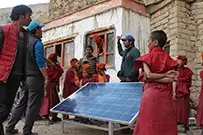 | Through their transformative approach, GHE not only redefined the way we travel but also paved the way for a more responsible tourism industry with a focus on connecting remote villages to the mainstream tourism industry in a sustainable manner. Global Himalayan Expedition (GHE) has achieved a remarkable decade of sustainable impact in the remote Himalayan regions. Through their unique approach, combining adventure tourism and social impact, GHE has empowered communities, brought clean energy, and created eco-friendly destinations. Their pioneering spirit and comprehensive approach have set a new standard for responsible and transformative tourism. 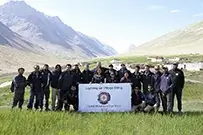 Know More |
| 11Central Nodal Agency Rural Tourism and Rural Homestays |
 | #RuralTourismAbode | Pochampally 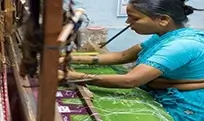 Pochampally, a 28-square km weavers’ hamlet on the outskirts of Hyderabad, has been catapulted onto the global stage after bagging the 'Best World Tourism Village’ tag awarded by United Nations World Tourism Organisation (UNWTO). The village is a shimmering pleats of colour with billboards of silk sarees, cotton fabrics. Popularly known for famed IKAT style whose creations include the attractive “Tie and Dye” and Silk oven sarees. It is located at 45 kms from Hyderabad, the Capital City of Telangana State & ~ 25 km from Ramoji Film City, the major tourism hub of Telangana. - Pochampally in Nalgonda district is often referred to as the silk city of India for the exquisite sarees that are woven through a unique style called Ikat. This style, Pochampally Ikat, received a Geographical Indicator (GI Status) in 2004.
- Pochampally’s unique weaving styles and patterns received special focus through the Prime Minister’s mantra of Vocal 4 Local as a part of Atmanirbhar Bharat.
- This is the place from where Bhoodan movement was started by Acharya Vinoba Bhave in 1951, hence place is renowned 'Bhoodan Pochampally
| Driving Forces For Developing Pochampally Rural Tourism - Its proximity to a cosmopolitan city like Hyderabad and tourist hub of Ramoji Film City.
- Growth of technology hubs in Hyderabad with high potential target group has compatible incomes, increased purchasing capacity, less exposure to rural lifestyle and indigenous culture, demand for novel experiences and keen interest in weekend getaways and short distance travels.
- Established market and demand for Pochampally handloom products in Hyderabad provides a great opportunity of introducing buyers directly to the weavers.
- Pochampally is an unique Rural Tourism site with multi-faceted set of attractions for various demographic and age based target groups.
- It offers a wide range of activities along with enough interest based activities to make an ideal weekend getaway and a short excursion from Hyderabad and/or Ramoji Film City.
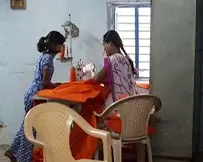 | Impacts Of Developing Rural Tourism Project - Project spearheaded to local employment generation, improved quality of life and livelihood options of the local community.
- Enhanced cultural significance & sense of cultural identity among community.
- Provided better access to higher education, health care facilities, infrastructure and equal opportunity for economic growth of the beneficiaries.
- Laid its focus on sustainable growth, socio-economic development, inclusiveness thus impacting positively.
- Created opportunity for small entrepreneurs to initiate business like handicraft centres, food stalls, etc.
- Has improved quality of life by provision of improved infrastructure facilities such as excellent road connectivity, water supply, sewerage, sanitation etc.
- Community experiences different cultural practices which enriches experiences, broadens horizons and increases insight and appreciation for different approaches to living.
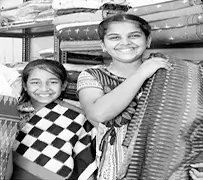 |
| 12Central Nodal Agency Rural Tourism and Rural Homestays |
 | #RuralTourismRoutes | How To Reach Pochampally is well connected with the twin cities of Telangana (Hyderabad &Secunderabad), Rajiv Gandhi International Airport in Hyderabad is most nearby airportand is about 76 kilometers away. Secunderabad Junction is the nearest railway station.Pochampally is well-connected by road, and can be reached from Hyderabad by taking theHyderabad-Warangal Highway (NH163) to Bhongir (12 kms to Pochampally). | Day 1 - 09:00 hrs - Arrive in Pochampally and check-in to your accommodation.
- 10:00 hrs - Breakfast
- 11:00 hrs - Exploration by visiting the Pochampally Handloom Park
- 14:00 hrs - Traditional Lunch.
- 16:00 hrs - Shopping exquisite Pochampally sarees and other handloom products.
- 18:00 hrs - Snacks.
- 19:00 hrs - Take a stroll through the village, interact with the locals, and witness the vibrant cultural activities.
- 21:00 hrs - Traditional Dinner
- 22:00 hrs - Lights off
| 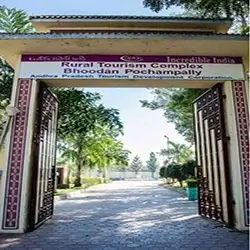 |
| 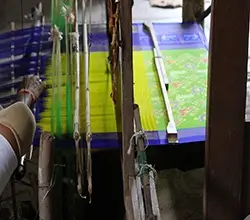 | Day 2 - 06:00 hrs - Wakeup call
- 07:00 hr - Fresh up and Breakfast
- 11:00 hrs - Visit the local market to explore more textile shops and handicrafts.
- 13:00 hrs - Lunch
- 14:00 hrs -Visit the Pochampally Handicrafts Cooperative Society, a government-supported initiative that promotes the art of handloom weaving
- 17:00 hrs - Snacks
- 18:00 hrs - Enjoy a cultural show or workshop organized by local artisans.
- 21:00 hrs - Dinner
- 22:00 hrs - Lights off
|
| Day 3 - 06:00 hrs - Wakeup call
- 07:00 hr - Fresh up and Breakfast
- 09:30 hrs - Visit the famous Yadagirigutta Temple dedicated to Lord Narasimha, an incarnation of Lord Vishnu.
- 11:00 hrs - Return to Pochampally and visit the Pochampally Museum.
- 13:00 hrs - Lunch
- 14:00 hrs - Leisure Time
- 17:00 hrs - Snacks
- 18:00 hrs - Spend your last evening in Pochampally by enjoying a relaxing walk around the village and time to depart.
| 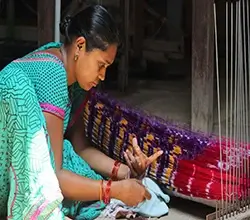 |
| 13Central Nodal Agency Rural Tourism and Rural Homestays |
 | #RuralTourismComic | | 14Central Nodal Agency Rural Tourism and Rural Homestays |
 | #RuralTourismTrivia |  | Across - 2. The Pencil Village of India.
- 4. India's Abandoned Ghost Village in Tamil Nadu.
- 6. India's 1st ODP Village.
- 7. World Oldest Democratic Village.
| Down - 1. Smart Village of Tamil Nadu.
- 3. Whistling Village of India.
- 5. The Hidden Jewel of Ladakh & 1st Astro Village of India.
| - 7. Malana
- 6. Thandavampatti
- 5. Maan
- 4. Dhanushkodi
- 3. Kongthong
- 2. Wakhoo
- 1. Odanthurai
- ANSWER
| 15Central Nodal Agency Rural Tourism and Rural Homestays |
 | | | Central Nodal Agency Rural Tourism and Rural Homestays |
|
|